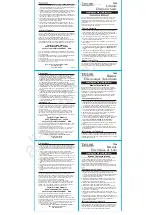
ELECTRONIC PRECISION SCALE
USER MANUAL
FOR MODEL PV-60, PV-100, PV-200, and PV-500
PLEASE READ BEFORE USING SCALE
1.
GENERAL DESCRIPTION
This is a portable top-loading digital electronic scale. The sensing mechanism is a load cell.
2.
INSTALLATION
A.
Set the scale on a flat, rigid surface, located away from dust, vibration, extreme heat sources,
electromagnetic sources such as electric motors or generators, and fluorescent lamp starters
(within 3 feet typically). Any slope may lead to inaccurate readings. For greater accuracy,
recalibrate the balance (see below) whenever the balance is relocated.
In the event of temperature change, allow 1-2 minutes for the scale to stabilize.
3.
PANEL LAYOUT AND DISPLAY FORMAT
A.
Panel Layout
a.
“ON” key – used to turn on the scale.
b.
“TARE” key – used to zero the scale, or for taring a container to eliminate its weight.
c.
“MODE” key – a short press selects grams, oz., troy oz., or pennyweight.
d.
“OFF” key – used to turn off the scale.
B.
Display Format
a.
This is a 4-digit liquid crystal display. Weighing units are shown on the right-hand side of the
display.
b.
When first turned on, the display shows all possible display segments, confirming that power
is “on,” and then the scale begins its search for zero.
c.
“EE” or “-EE” indicates overload or underload respectively. When the “E. .E” signal blinks, it
indicates that the tare process is prohibited die to the overload or underload conditions.
d.
“Cb” indicates the power from the battery is too low for normal operation.
e.
Battery Saver feature – scale will automatically shut off after an average of 5-7 minutes to
save battery life.
4.
CALIBRATION PROCEDURE
A.
Make sure scale is in the gram mode.
B.
Press TARE key – scale will read zero.
C.
Place correct calibration weight on platform.
PV – 500 = 200g calibration weight
PV – 200 = 100g calibration weight
PV – 100 = 50g calibration weight
PV – 60 = 50g calibration weight
Any electronic balance may be calibrated periodically to assure it accuracy.






















